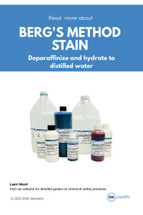Jun 26th 2025
Disodium Phosphate Buffer Solution
Vital Scientific Tool in Day-to-Day Activities
Buffer solutions are more than just chemical solutions, they quietly set the conditions under which most biological and chemical reactions happen. One such solution, the Disodium Phosphate Buffer, has become an everyday essential in labs due to its stability, affordability, and compatibility with living systems.
Take enzymes, for example. These tiny protein catalysts are incredibly sensitive to pH. Even a slight drift away from the optimal pH range can dramatically reduce their activity, or shut it down altogether. The same goes for proteins in general; they denature quickly if their environment isn’t stable. And in molecular biology, from PCR to DNA extraction and gel electrophoresis, consistent buffered conditions are a non-negotiable part of getting reliable results.
That’s where disodium phosphate buffer proves its value. It's dependable, easy to prepare, and plays well across various laboratory applications without complicating your workflow.
Common Use Cases in the Laboratory and Other Settings
This solution isn’t limited to academic experiments. It plays a key role in pharmaceutical manufacturing, particularly in keeping injectable formulations within a safe and stable pH range. It’s also a key ingredient in diagnostic reagent prep, especially for test kits used in clinical settings. And in industries like food safety, it's part of the backbone of quality control procedures.
Some typical applications include:
- Preparing samples for chromatography
- Acting as a transport medium in protein purification
- Providing pH stability in microbiological growth media
- Serving as a buffer in ELISA and other immunoassays
- Maintaining pH in cosmetic and personal care formulations
What sets phosphate buffers apart is their neutrality in chemical reactions. Unlike other systems, they remain chemically stable and don't interfere with most biological processes. That’s why so many industries rely on them.
Knowing the Chemistry: Scalable Stability
Chemically, disodium phosphate brings two key benefits to the table: buffering capacity and stability. When stored correctly, these solutions remain usable for long periods without oxidizing or degrading, something that can’t be said for more volatile buffers. That makes it an excellent fit for sterile applications like pharmaceutical prep or cell culture.
And scalability is a huge plus. Whether you need 100 mL for a small experiment or 50 liters for a quality control routine, the buffer behaves exactly as expected. That’s the kind of consistency that labs can rely on, and build protocols around.
Options for Concentration and Packaging
At Eng Scientific, the Disodium Phosphate Buffer Solution is available in standard molarities such as 0.1 M, 0.2 M, 0.5 M, and 1.0 M. Custom concentrations can also be provided upon request to meet specific application needs.
Most formulations are available in liquid, ready-to-use formats, reducing prep time and eliminating inconsistencies. Whether you're running a low-volume academic lab or a high-throughput production line, there's a packaging size to match your needs, from 100 mL bottles to 5-liter containers.
Need sterile filtration? That’s available too. Every batch is shipped with a Certificate of Analysis (COA) and Material Safety Data Sheet (MSDS) to ensure compliance with lab safety and regulatory requirements.
An Affordable Option for High-Throughput Labs
One major advantage of disodium phosphate buffer is its cost-efficiency. While there are plenty of newer buffer systems on the market, many tailored to highly specific applications—phosphate buffers remain a smart go-to for day-to-day lab operations.
When ordered in bulk, they become even more budget-friendly. This is especially valuable for institutions working under tight financial constraints. Plus, thanks to its versatility, this buffer can often be used across multiple departments, streamlining both procurement and storage.
Who Uses It, and Why
- Disodium phosphate buffer is a mainstay across several industries:
- Academic labs rely on it for general assays and teaching experiments.
- Biotech startups use it during early-stage research and development.
- Pharmaceutical companies include it in drug formulations and clinical trial setups.
- Food & beverage producers depend on it for shelf-life studies and safety testing.
- It also has a key role in diagnostics, particularly in immunoassays like ELISA. For example, it’s used to dilute antibodies or wash microplates, applications where pH precision matters. A poorly buffered solution here can completely skew the final data.
Conclusion: Reliable, Easy to Use, and Broadly Relevant
In scientific work, controlling variables is everything. The fewer moving parts, the easier it is to identify real results, debug problems, and maintain quality standards. That’s exactly what Disodium Phosphate Buffer Solution delivers: a steady, no-nonsense way to keep your experiments and formulations within the right pH window. Whether you're managing a lab bench or overseeing a production line, investing in a reliable buffer isn’t just about following protocols, it’s about protecting the integrity of your work.
For packaging options, bulk pricing, or to place your order, visit https://engscientific.com and explore our full range of laboratory buffer solutions.

